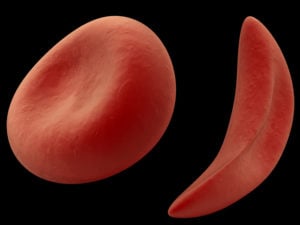
Sickle Cell Disease is the most common form of inherited blood disease and affects about 90,000 – 100,000 Americans[1]. Sickle Cell Disease causes the red blood cells to become hard and sticky, and look like a C-shaped farm tool called a “sickle.” People with Sickle Cell Disease can live full lives and enjoy most of the activities that other people do. However, the symptoms can progress and impair an individual’s ability to work. This Blog article will address the physical symptoms presented by Sickle Cell Disease that may impair an individual’s ability to work. An inability to work will typically prompt an application for Social Security disability benefits.

Treatment for Sickle Cell Disease includes antibiotics, pain management and blood transfusions. About half of people with sickle cell anemia survive to age 50. Generally, Sickle Cell Disease is not curable, except in rare instances by bone marrow transplantation.
The ultimate question in a disability case where the person was working, then has to stop working because of the symptoms of their disease would be: Can the person, given their residual functional capacity perform either their past work or any other work in the national economy? Of course, to answer this, you would need the person’s residual functional capacity, or in other words, what an individual is able to do, despite functional limitations resulting from Sickle Cell Disease (or a medically determinable complication) and condition-related symptoms.
Clinical Problems Caused by Sickle Cell Disease
- Anemia
- Acute Splenic Sequestration
- Acute Splenic infarction
- Transient Aplastic Crisis
- Hepatic Sequestration
- Jaundice
- Visual impairment
- Hand-foot syndrome
- Growth impairment
- Cardiomyopathy
- Strokes
- Acute chest syndrome
- Infections
- Pain ( thrombotic, vaso-occlusive ) crises
- Leg Ulcers
- Damage to Major Organs
- Pulmonary hypertension
Residual Functional Capacity
Although the sickle cell trait is not serve in and of itself, the condition can cause significant limitations in some individuals. Even if a claimant with Sickle Cell Disease appears physically strong, possibly lethal or crippling consequences ( Stroke, heart attack ) can occur if the red blood cells are stressed enough to deform. There are also hot and cold stressors for persons with Sickle Cell Disease. Therefore, it is common to have environmental limitations.
Additionally, physical activities may result in limiting fatigue or have resulted in previous serious medical complications. In addition, If there are additional complications, such as visual, neurological, cardiac, etc., these impairments will also be carefully evaluated and weighed.
As is the case with most medical conditions and Social Security disability, it is not the severity of the diagnosis, but how that condition limits the individual’s ability to work. If you have questions regarding Sickle Cell Disease and Social Security disability, or have other questions for a Tampa Social Security Disability Lawyer, call our office for a free consultation.
[1] http://www.cdc.gov/ncbddd/sicklecell/data.html
